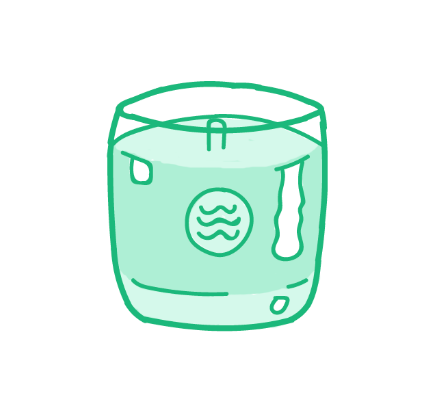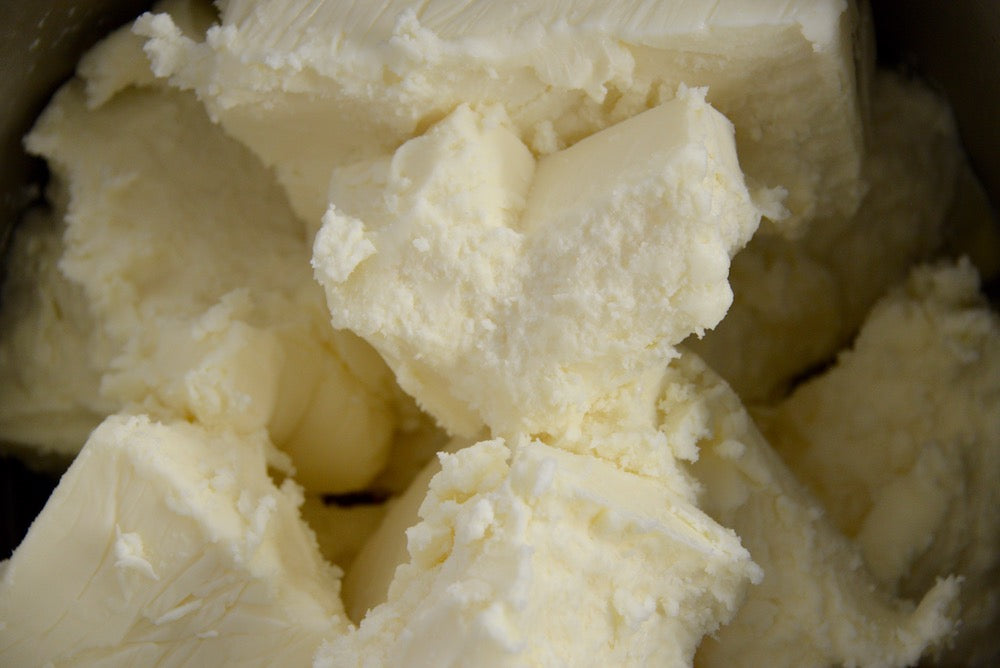Paraffin was the chandler's wax of choice since the late 19th century due to its plentiful supply as a byproduct of the oil industry. Recently, soy wax has become more prevalent in craft candle making due to its “natural” credentials. On the hunt for a truly sustainable option, we settled on lesser-known alternatives: Since 2015, we've used coconut wax—except for in the Summer of 2022, when we experimented with using regenerative palm wax!
As of September 2022, we temporarily transitioned back to coconut wax while we continue improving our regenerative palm wax blend. We hope to have our palm wax pouring again in the near future. Our current coconut wax is composed of high melt point coconut oil, soy wax, and organic-certified beeswax.

What is wax, and what is the difference between a wax and an oil?
As noted in our previous article on waxes, a wax has a fairly broad definition: it’s a flammable, carbon-containing solid that becomes liquid when heated above room temperatures. So the difference between a wax and oil is that a wax remains solid at room temperatures while an oil liquefies.
What is coconut wax?
Anyone who has used coconut oil at home knows that on a hot day it liquefies, and likely, have also noticed its faint ‘coconut’ odor. This leads to two common questions about coconut wax “What’s different between coconut oil and wax?” and “Doesn’t coconut wax smell of coconut”?.
Given its tendency to melt at room temperatures, coconut oil is not a wax. Our coconut wax uses use a hydrogenated and refined coconut oil. The refining process removes the coconut scent, while hydrogenation increases the melt point substantially from ~75 ºF to ~100 ºF. So with our ‘high-melt’ coconut oil, we’re a step closer to a wax, but still not quite there. The coconut oil is then blended with other natural vegetable waxes to bring up the melt point further to avoid any 'liquefying' issues. In summary, coconut wax is a high melt-point coconut oil and other natural waxes blended to achieve a wax that’s solid at room temperature. The inclusion of the coconut oil leads to a wax that burns very evenly compared to others, and from our own tests, more slowly too.

What are the other waxes in the blend?
There is an impressively low number of wax blenders selling coconut wax in the United States currently. We only found one that made a blend that was high quality and could truly be called a coconut wax—others we found sell a product called coconut wax that is mostly soy wax, with a small amount of added coconut oil. We know from our supplier that the coconut wax is all-natural (i.e. 100% no paraffin) and made from a majority high melt-point coconut oil (i.e. > 50% coconut-based). Unfortunately our supplier won't give us specific details or breakdown of what the vegetable waxes are in our blend, as it's a trade secret proprietary to them, since their lab created the wax. The reason they do this is to avoid other wax blenders copying their formula.
Since we wanted to know, we recently ran a chemical analysis on the wax. It identified that the majority ingredient was coconut oil, and that the ‘other vegetable waxes’ include some amount of soy. The analysis indicated that it was highly unlikely that the blend contained palm wax, but couldn’t rule it out completely.
Little did we know that a carefully sourced palm wax would ultimately become the solution we'd dream of.
Towards Regeneration with Palm
Palm wax was initially heralded as the holy grail of the candle industry. With a pleasant aesthetic, “feathered” effect, and a similar burn quality as that of coconut wax, palm wax was once viewed as the sustainable alternative. However, a 2009 investigation by the Economist (“The other oil spill”) discovered that, even with the creation of the Roundtable on Sustainable Palm Oil (RSPO), deforestation practices were rampant and endangering many species of animals as demand for palm wax skyrocketed. To this day, it’s challenging to source truly sustainable palm oil products.
This is unfortunate because palm oil is a potentially sustainable crop. Currently, most palm oil is grown and harvested in an unsustainable and destructive manner, wreaking havoc on the local ecosystem, communities, and the climate. However, this has nothing to do with the inherent qualities of palm (which scores higher than most other oil sources in many respects) and everything to do with poorly managed industries and supply chains. It is completely possible and desirable to have a fair-trade and organic palm oil supply.
In 2019, we traveled to North America’s biggest natural products show, ExpoWest, in the hopes of finding some inspiring companies to learn from and work with. We were not disappointed. We learned about the work of one of Dr. Bronner’s key palm oil suppliers, Natural Habitats, and the growing movement toward regenerative farming practices.

Natural Habitats help grow and produce organic oil palms in Ecuador. They do this through methods that transform previously deforested farmland into healthy forest ecosystems. Their oil palm has gained the most stringent certifications associated with healthy farming practices, from regenerative organic and fair trade to Non-GMO and Fair for Life. Unlike traditional large-scale monocrop plantations, Natural Habitats focuses on driving a future where oil palm farms help support the surrounding places, people, and environments.
We now understand that oil palm can be cultivated in a way that leaves the planet and people better off and has opened our minds to palm’s potential. Rather, we must move away from the destructive methods used to cultivate it. Regenerative palm farming offers us a blueprint for the immense potential to change the world through restorative farming practices via the production methods we support, not just the ingredients we buy. There are more profound lessons in this, too, about rethinking how we operate our company and about our own individual impacts.
With this spirit, we have worked tirelessly to take Natural Habitats’ palm wax and figure out the best methods to use it in all our scented candles. Finally, after many years of experimentation, we found ways to make a workable candle with this precious ingredient. As of June 2022, we’re ready to move ahead with this new ingredient as the basis for all our candles, and we’re incredibly excited to start pouring our candles with this wax. You can learn more about our palm wax choice here.
Questions, ideas, candles? TheLab@KeapBK.com














